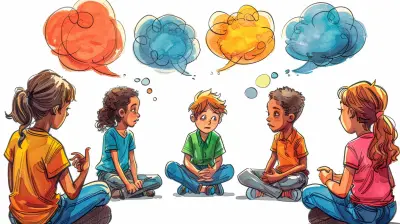Project-Based Learning for Language Acquisition and Development
5 July 2025
Language learning isn’t just about memorizing vocabulary and grammar rules—it’s about using the language in real-life situations. This is where Project-Based Learning (PBL) shines! Imagine learning a new language not by sitting through lectures but by diving into meaningful projects that make you think, collaborate, and communicate. Sounds exciting, right?
In this article, we’ll break down how Project-Based Learning (PBL) can revolutionize language acquisition, making it more engaging, practical, and effective. 
What is Project-Based Learning (PBL)?
Before we dive into the specifics of language learning, let’s get a clear idea of what Project-Based Learning (PBL) really is.PBL is an educational approach where students learn by doing. Instead of passively absorbing information, they work on real-world projects that require critical thinking, creativity, and collaboration.
For example, instead of learning about food vocabulary in a traditional classroom setting, a PBL approach would involve planning and hosting a cultural food festival, where students would have to research, prepare presentations, and interact using the language they’re learning.
This hands-on approach makes learning more meaningful and memorable. 
Why is PBL Effective for Language Acquisition?
Learning a new language can feel overwhelming, but PBL helps break down the process naturally. Here’s why it works so well:1. Encourages Real-World Use of Language
Ever learned a bunch of grammar rules only to forget them when trying to have a real conversation? That’s because memorization alone doesn’t help us develop fluency.With PBL, learners use the language in authentic situations, such as creating a travel brochure, conducting interviews, or scripting and performing a play. This real-life application helps reinforce language skills in a way that traditional learning methods can’t.
2. Boosts Motivation and Engagement
Let’s be honest—traditional language classes can sometimes feel…boring. Endless worksheets and drills don’t always keep learners engaged.PBL, on the other hand, makes learning more interactive and fun. When students work on meaningful projects, they take ownership of their learning, making them more committed and motivated to improve their language skills.
3. Promotes Collaborative Learning
Language is all about communication, and what better way to practice than working with others?PBL often involves teamwork, requiring students to communicate, problem-solve, and share ideas—all in the target language. This creates a natural language-learning environment where students learn from each other while building crucial social skills.
4. Develops Critical Thinking and Creativity
Learning a language isn’t just about memorization—it’s about thinking and expressing ideas.Through PBL, students engage in problem-solving, decision-making, and creative expression, helping them develop a deeper understanding of the language rather than just learning surface-level vocabulary and grammar. 
How to Implement PBL in Language Learning
So, how can we actually use PBL to improve language acquisition? Let’s break it down into actionable steps:1. Choose a Meaningful Project Theme
The first step is to select a project that aligns with student interests and real-world applications. Here are a few great project ideas for language learners:- Creating a travel guide for a country where the language is spoken
- Producing a short film entirely in the target language
- Hosting a cultural event with presentations and performances
- Writing and illustrating a children's book in the second language
- Interviewing native speakers and creating a documentary
A meaningful project makes students eager to participate, ensuring better language retention.
2. Incorporate All Language Skills (Reading, Writing, Listening, Speaking)
A solid language-learning project should engage all four key skills:- Reading: Researching information for the project
- Writing: Creating scripts, reports, or presentations
- Listening: Understanding spoken language in interviews or recordings
- Speaking: Presenting findings or discussing project-related tasks
By integrating these skills into a single project, students get a well-rounded language-learning experience.
3. Encourage Student Collaboration
Language is best learned through interaction. Encourage students to work in teams, discuss ideas, and negotiate meanings—all in the target language.For example, if they’re working on a travel guide, they can:
- Discuss and decide on locations to feature
- Assign writing sections to different team members
- Practice presenting their findings in front of the class
These activities naturally develop communication skills and boost confidence in language use.
4. Utilize Technology and Multimedia
In today’s digital world, technology can enhance language learning immensely. Encourage students to use digital tools such as:- Video editing software for creating short films
- Podcasting apps for recording discussions
- Online collaboration tools like Google Docs for writing projects
- Language-learning apps for additional practice
By integrating technology, students engage with the language in multiple ways, reinforcing their learning.
5. Provide Constructive Feedback and Reflection
Feedback is crucial in language learning. Throughout the project, encourage students to:- Reflect on their progress (What did they do well? What could improve?)
- Give peer feedback (Constructive comments on language use)
- Receive teacher feedback (Guidance on pronunciation, grammar, and fluency)
Reflection helps students identify strengths and weaknesses, increasing their awareness of language development. 
Real-Life Success Stories of PBL in Language Learning
Many language educators have embraced PBL with remarkable success. Let’s take a look at a few real-world examples:- The “Cultural Exchange” Project: A group of Spanish learners connected with students from a Spanish-speaking country through video calls, sharing presentations about their cultures entirely in Spanish. This created a real, meaningful exchange, improving language skills dramatically.
- The “Local Food Documentary” Project: English learners researched traditional foods from their hometowns, interviewed chefs, and created a short documentary in English. This practical application helped them develop confidence in speaking and listening skills.
- The “Business Pitch” Project: French learners created a startup idea and pitched it as if they were presenting to investors in France. This simulation enhanced their professional vocabulary and speaking skills.
These examples show that learning a language through projects isn’t just effective—it’s also exciting and rewarding!
Final Thoughts
Project-Based Learning isn’t just another teaching trend—it’s a powerful, engaging approach that makes language learning meaningful and effective.By immersing students in real-world tasks, encouraging collaboration, and fostering critical thinking, PBL helps learners develop language skills naturally, without the usual stress of memorization and drills.
So, whether you’re a teacher looking for engaging methods or a student struggling with conventional learning, try PBL—you’ll be amazed at how much more fun and effective language learning can be!
all images in this post were generated using AI tools
Category:
Project Based LearningAuthor:

Eva Barker
Discussion
rate this article
1 comments
Mary Campbell
Project-Based Learning: where tossing around vocabulary isn't just a classroom exercise—it's a thrilling treasure hunt! Who knew mastering a language could involve more teamwork than a cooking show, minus the burnt soufflés? Bon appétit to language skills!
July 14, 2025 at 11:50 AM

Eva Barker
Thank you for the fun analogy! Project-Based Learning truly transforms language acquisition into an engaging adventure. I'm glad you enjoyed it!


